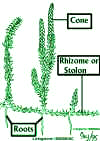As we have
seen, there are several types of stems produced by Lycopodium.
These include an underground Rhizome, a horizontal Stolon and Aerial Stems.
Diagram of a Lycopodium Plant
The Apical Meristem is
multicellular. This distinguishes it from the other plants we have seen so far.
Multicellularity is a feature of the most advanced plants and probably represents a
significant adaptation. However, it is unclear how this might be advantageous. Presumably
the multicellular apex may have greater flexibility in terms of leaf initiation &
possibly in terms of internal tissue differentiation.

Lycopodium Shoot Apical Meristem (SAM) with Leaf Primordia.
Leaves are initiated from single cells or
a small group of cells, close to the Shoot Apical Meristem (SAM).
This is typical for most vascular plants.
The Epidermis
of the stem typically has Stomata. The
outer Cortex usually contains Chlorenchyma.
This photosynthetic tissue may contain a lot of air spaces
& can be continuous with the leaves. The take home message is that the stems can make a major contribution to
the total amount of photosynthesis that takes place in Lycopodium. Microphylls represent a significant advance compared to leaves of
the Bryophyta. However, the plant may still need a strong contribution from its stem in
order to survive & thrive.
Some of the internal cortical cells have thick
walls which become lignified. These constitute Sclerenchyma
tissue which imparts strength to the stem. Sclerenchyma cell walls typically contain Lignin and stain red with
Phloroglucinol. Leaf traces are present.